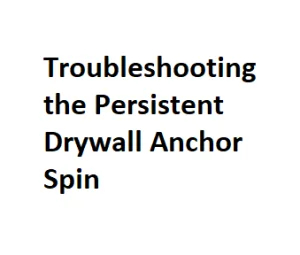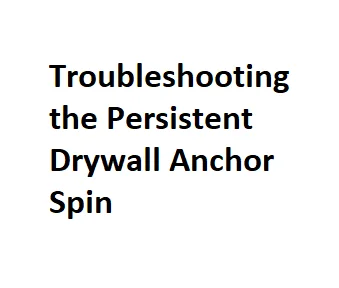Troubleshooting Tips for Lingering Spinning Issues:
Even with the best intentions and careful execution, unexpected challenges may still arise. If you find yourself facing persistent spinning issues despite following the initial steps, consider these troubleshooting tips:
- Anchor Removal and Reinstallation:
- If the anchor is still spinning after installation, carefully remove it and inspect the hole. Clean out any debris or dust that may have accumulated during the initial attempt. Once the area is clear, try reinstalling the anchor.
- Use Multiple Anchors:
- Distributing the weight across multiple anchors can provide additional stability. Instead of relying on a single anchor, use two or more for larger items. Make sure they are evenly spaced and aligned to support the load effectively.
- Patch and Repair:
- In cases where the drywall has been compromised due to repeated attempts, consider patching and repairing the hole. Use a quality patching compound to restore the integrity of the wall before attempting to install a new anchor.
- Professional Assistance:
- If all else fails, it might be time to seek professional help. A local handyman or contractor can assess the situation, identify any underlying issues, and provide a reliable solution. They may also have access to specialized tools or anchors that can better address your specific needs.
- Explore Alternative Hanging Solutions:
- If the spinning issue persists, it might be worth considering alternative hanging methods. Command strips, adhesive hooks, or other innovative hanging solutions might be suitable for lighter items and eliminate the need for traditional anchors altogether.
Additional Tips for Long-Term Success:
- Anchor Quality Matters:
- Invest in high-quality anchors. While it might be tempting to opt for the cheapest option, a sturdy anchor can make a significant difference in preventing spinning issues. Look for anchors with good reviews and a reputation for reliability.
- Consider Anchor Size:
- Ensure the anchor size matches the weight and size of the item you’re hanging. Using an anchor that is too small for the load may lead to instability and spinning. Refer to the anchor’s weight capacity specifications and choose accordingly.
- Mind the Gap:
- When installing anchors, be mindful of any gaps between the anchor and the wall. A gap can allow the anchor to spin more freely. If you notice a gap, try tightening the anchor a bit more to reduce movement.
- Evaluate Wall Thickness:
- If your walls are thicker than the standard drywall, adjust your approach accordingly. Longer anchors or toggle bolts may be necessary to penetrate the extra depth and provide a secure hold.
- Use a Screwdriver for Tightening:
- Instead of relying solely on a drill, consider using a screwdriver for the final tightening of the anchor. This manual approach allows for better control and can help you gauge the anchor’s resistance, reducing the likelihood of over-tightening.
- Patience is Key:
- Rushing through the installation process can lead to mistakes. Take your time, follow each step carefully, and ensure the anchor is properly seated before moving on. Patience can make the difference between a secure hang and a spinning disappointment.
- Learn from Each Attempt:
- Treat each attempt as a learning experience. If an anchor spins, assess what went wrong and adjust your approach accordingly. Continuous improvement is the key to mastering the art of drywall hanging.
- Share Your Wisdom:
- If you successfully overcome the spinning anchor challenge, share your knowledge with friends or online communities. DIY enthusiasts often benefit from shared experiences, and your tips could help someone else avoid the frustration you’ve experienced.
Common Causes
| S.No |
Cause |
Description |
Solution |
Prevention |
| 1 |
Loose Drywall |
Drywall anchors can spin if the surrounding drywall is loose. |
Tighten surrounding drywall with screws. |
Ensure proper installation of drywall. |
| 2 |
Incorrect Anchor Size |
Using the wrong size of drywall anchor can lead to spinning. |
Choose anchors that match the weight/load. |
Carefully select appropriate anchors. |
| 3 |
Over-tightening Screws |
Over-tightening the screws may strip the anchor hole. |
Use appropriate force when tightening screws. |
Follow manufacturer’s installation guidelines. |
| 4 |
Weak Drywall Material |
Low-quality or damaged drywall can contribute to spinning. |
Replace weak drywall with a stronger material. |
Choose high-quality drywall materials. |
| 5 |
Improper Anchor Installation |
Incorrect installation can result in instability. |
Follow proper installation instructions. |
Seek professional assistance if needed. |
Symptoms
| S.No |
Symptom |
Description |
Possible Cause |
Recommended Action |
| 1 |
Continuous Rotation |
The anchor rotates continuously without securing. |
Loose drywall or incorrect anchor size. |
Check drywall tightness and anchor size. |
| 2 |
Frequent Repositioning |
The anchor shifts position easily. |
Weak drywall or improper installation. |
Reinforce weak areas and reinstall. |
| 3 |
Visible Cracks Around Anchor |
Cracks appear in the drywall around the anchor. |
Over-tightening screws or weak material. |
Adjust screw tightness and repair cracks. |
| 4 |
Limited Weight Support |
Anchor fails to support the expected weight. |
Incorrect anchor size or weak drywall. |
Upgrade to a larger anchor or stronger drywall. |
| 5 |
Uneven Load Distribution |
The load is not evenly distributed on the anchor. |
Improper installation or anchor placement. |
Reinstall the anchor with proper alignment. |
Troubleshooting Steps
| S.No |
Step |
Description |
Action |
| 1 |
Check Drywall Tightness |
Ensure the drywall around the anchor is securely in place. |
Tighten loose drywall with screws. |
| 2 |
Verify Anchor Size |
Confirm that the anchor size matches the load requirement. |
Replace with the correct anchor size. |
| 3 |
Adjust Screw Tightness |
Modify the tightness of screws to prevent stripping. |
Loosen or tighten screws accordingly. |
| 4 |
Inspect Drywall Quality |
Examine the drywall for weaknesses or damage. |
Replace weak drywall sections. |
| 5 |
Reinstall Anchor Properly |
Follow proper installation guidelines and ensure stability. |
Reinstall anchor with correct steps. |
Tools and Materials
| S.No |
Item |
Description |
Usage |
| 1 |
Screwdriver |
Tool for tightening or loosening screws. |
Adjust screw tightness. |
| 2 |
Level |
Ensures proper alignment during installation. |
Check for even load distribution. |
| 3 |
Stud Finder |
Locates studs for secure anchor placement. |
Identify secure mounting points. |
| 4 |
Replacement Anchors |
Various sizes and types for different applications. |
Replace with correct anchor size. |
| 5 |
Drywall Repair Kit |
Includes materials for patching and reinforcing drywall. |
Repair cracks and weak areas. |
Preventive Measures
| S.No |
Measure |
Description |
Implementation |
| 1 |
Regular Inspection |
Periodically check for any signs of anchor issues. |
Address problems before they escalate. |
| 2 |
Use High-Quality Anchors |
Invest in anchors of reliable quality and durability. |
Choose reputable brands and products. |
| 3 |
Follow Manufacturer Guidelines |
Adhere to the recommended installation instructions. |
Ensure proper anchor placement. |
| 4 |
Distribute Weight Evenly |
Avoid placing excessive weight on a single anchor point. |
Use multiple anchors for heavy loads. |
| 5 |
Professional Installation |
Seek professional help for complex installations. |
Ensure anchors are securely installed. |
Final Thoughts:
Conquering the spinning drywall anchor may require a blend of artistry and science, but armed with the right knowledge and a touch of perseverance, you can transform your living space into a gallery of your personal style. Embrace the learning process, adapt your techniques as needed, and soon you’ll be hanging your favorite pieces with confidence, free from the torment of a spinning anchor. Happy hanging!


